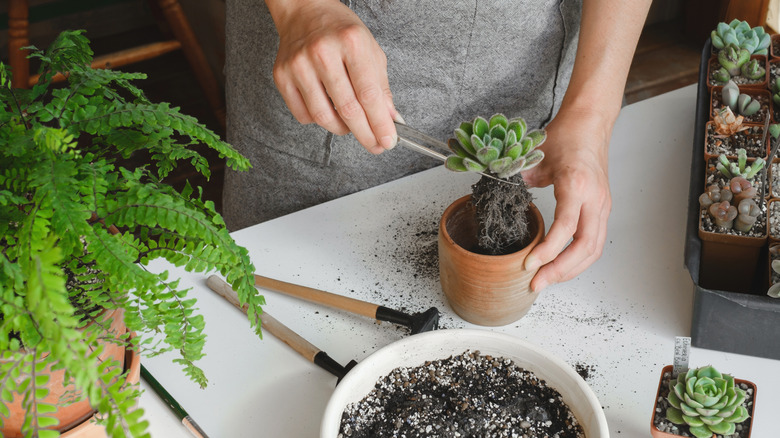How To Repot A Succulent In 15 Seconds Or Less
Repotting a succulent (or any plant, really) can be a tedious and messy task, between choosing the right container and carefully moving your plant baby from one home to the next. Succulents may be low-maintenance and content in smaller containers thanks to their minimal moisture needs, but even these resilient plants have their limits. Over time, succulents can become top-heavy or show signs of nutrient depletion. Yellowing and browning leaves, known as chlorosis, may indicate a nitrogen deficiency, according to the University of Connecticut's College of Agriculture, Health, and Natural Resources.
If your succulent seems unhealthy even between waterings and after soaking up its usual dose of indirect sunlight or has outgrown its current pot, it might be asking for a new planter and a fresh batch of soil. And we've found a clever hack to repot your succulents like a pro in 15 seconds or less. Here's how to do it: Grab a new, larger pot and fill it about a quarter full with succulent-specific soil.
Next, place your succulent (still in its original pot) in the center of the new pot, and add more soil around it until the sides are filled. Gently remove the old pot and you'll have a space large enough for your succulent to be repotted. Now, carefully remove the succulent from its old pot and place it into its new home. It's a simple hack, but it can make the tedious job of repotting significantly easier.
Choosing the right pot size to repot a succulent
Pot size is everything when it comes to succulents because they flourish in smaller or shallower containers. Ideally, when repotting, you'll want to choose a pot that's just 1 to 2 inches larger than the one your plant is currently in. With succulents, it's best to lean toward the smaller end as too much space can actually stunt their growth. Extra soil tends to retain more moisture, which can lead to a very unhappy succulent.
You'll also want to make sure your new pot has drainage holes. Without them, excess water has nowhere to go, and your plant's roots could end up soaking for too long. So, if you plan on repurposing old teacups into planters, don't forget to drill a hole in the bottom so the water can escape.
Speaking of pot type, while those teacups will undoubtedly look adorable, succulents also do well in clay or terracotta pots. These materials promote quicker drying times, which creates the ideal environment for succulents to thrive. Now, before you go picking a new home for your succulent, remember it's best to repot them during their growing season — typically in the spring — and not when they're dormant.
